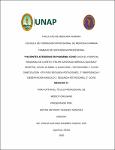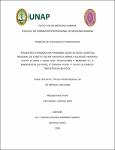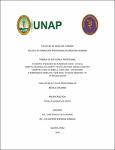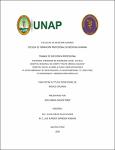| dc.contributor.advisor | Ramírez García, Edgar Antonio | |
| dc.contributor.author | Vásquez Sánchez, Bryan Anthony | |
| dc.date.accessioned | 2020-09-04T03:32:12Z | |
| dc.date.available | 2020-09-04T03:32:12Z | |
| dc.date.issued | 2020 | |
| dc.identifier.uri | http://repositorio.unapiquitos.edu.pe/handle/20.500.12737/6855 | |
| dc.description.abstract | A fines de Diciembre de 2019, se informó de un caso de neumonía no identificado en Wuhan, provincia de Hubei, República Popular China (PRC);1 siendo identificado el agente causal y ahora oficialmente nombrado SARS-CoV-2 (síndrome respiratorio agudo severo coronavirus 2) por el Comité Internacional de Taxonomía de Virus (ICTV),2,3 caracterizado por ser altamente infeccioso y virulento. La infección fue rápidamente propagándose en todo el mundo, por lo que la Organización Mundial de la Salud (OMS) la catalogó como un PANDEMIA COVID-19 el 11 de Marzo de 2020,4,5 la misma que hasta el 22 de Junio de 2020, notifica 8,860,331 casos confirmados y 465,740 muertes confirmadas por COVID-19 en todo el mundo entre 216 países, territorios o áreas.6 El Perú registra su 1er caso el 06 de Marzo,7,8,9 y la ciudad de Iquitos lo reporta el 17,10,11,12,13,14,15 tratándose de un hombre de 52 años, trabajador del sector turismo y que tuvo contacto con un numeroso grupo de personas asintomáticas que procedían del extranjero.
Ante el inminente decontrol y la gran amenza que supeditaba este virus mortal, el gobierno peruano declara el Estado de Emergencia a nivel nacional,16 donde las medidas dispuestas no fueron suficientes para frenar el contagio y la mortalidad en la región Loreto.
A casi un mes de registrado el primer infectado sintomático por SARS-CoV-2 en Loreto,10 y con la desesperación de la población así como la ansiedad llevaba al límite por el personal de salud, la región perdía la fe, fue entonces que se hizo un llamado a todo el personal de salud voluntario por parte de la Dirección Regional
xi
de Salud (DIRESA),17 capaz de sumar esfuerzos para no doblegar la actitud de los que luchaban en primera línea en el Hospital Regional de Loreto HRL COVID-19 ante un eminente colapso.
En promedio, fueron 50 las atenciones por médico de turno en el tópico emergencia, donde 15 a 20 pacientes eran ingresados diariamente hasta llenar las 300 camas en el servicio de hospitalización, incluyendo los servicios de contingencia en las áreas de Emergencia y Consultorios Externos, llegando a registrarse alrededor de 15 muertes por día sólo en el servicio de Emergencia.
En mi grado de bachiller de medicina, y sintiéndome no sólo capaz de estar a la altura de este acontecimiento por todo lo aprendido en la Facultad de Medicina Humana de la Universidad Nacional de la Amazonía Peruana FMH-UNAP y en mi etapa de interno de medicina, sino también en la obligación de estar presente por la vocación de servicio que me caracteriza, acudo al llamado desesperado de nuestras autoridades en salud de la región, y me pongo a su disposición de forma inmediata, todo lo cual permite la presentación del actual Informe de Trabajo de Suficiencia Profesional. | es_PE |
| dc.description.abstract | In late December 2019, an unidentified case of pneumonia was reported in Wuhan, Hubei Province, People's Republic of China (PRC);1 the causal agent being identified and now officially named SARS-CoV-2 (severe acute respiratory syndrome coronavirus 2) by the International Committee on Virus Taxonomy (ICTV),2,3 characterized by being highly infectious and virulent.
The infection was rapidly spreading throughout the world, so that the World Health Organization (WHO) catalogued it as a COVID-19 PANDEMIC on March 11, 2020,4,5 which until June 22, 2020, reported 8,860,331 confirmed cases and 465,740 confirmed deaths by COVID-19 worldwide among 216 countries, territories or areas.6
Peru registered its first case on March 6,7,8,9 and the city of Iquitos reported it on 17.10,11,12,13,14,15 The case involved a 52-year-old man who worked in the tourism sector and had contact with a large group of asymptomatic people from abroad.
In view of the imminent decontrol and the great threat that this deadly virus posed, the Peruvian government declared a nationwide State of Emergency,16 in which the measures taken were not sufficient to stop the spread of the virus and the mortality rate in the Loreto region.
Almost a month after the first symptomatic SARS-CoV-2 infection was registered in Loreto,10 and with the desperation of the population as well as the anxiety that the health personnel were carrying to the limit, the region was losing faith. It was then that a call was made to all volunteer health personnel by the Regional Health
xiii
Directorate (DIRESA),17 able to join forces so as not to break the attitude of those who were fighting on the front lines at the Loreto Regional Hospital HRL COVID-19 in the face of an eminent collapse.
On average, there were 50 visits per doctor on duty in the emergency area, where 15 to 20 patients were admitted daily until the 300 beds in the hospitalization service were filled, including the contingency services in the Emergency and Outpatient areas, with around 15 deaths per day registered in the Emergency service alone.
In my degree of medical school, and feeling not only capable of living up to this event because of everything I learned in the School of Human Medicine of the National University of the Peruvian Amazon FMH-UNAP and in my stage as a medical intern, but also in the obligation to be present because of the vocation of service that characterizes me, I go to the desperate call of our authorities in health of the region, and I put myself at their disposal immediately, all of which allows the presentation of the current Report of Work of Professional Sufficiency. | en_US |
| dc.description.uri | Trabajo de suficiencia profesional | es_PE |
| dc.format | application/pdf | es_PE |
| dc.language.iso | spa | es_PE |
| dc.publisher | Universidad Nacional de la Amazonia Peruana | es_PE |
| dc.rights | info:eu-repo/semantics/openAccess | es_PE |
| dc.rights | Attribution-NonCommercial-NoDerivs 3.0 United States | * |
| dc.rights.uri | http://creativecommons.org/licenses/by-nc-nd/3.0/us/ | * |
| dc.source | Universidad Nacional de la Amazonía Peruana | es_PE |
| dc.source | Repositorio institucional - UNAP | es_PE |
| dc.subject | Pandemia por el nuevo coronavirus 2019 | es_PE |
| dc.subject | Covid-19 | es_PE |
| dc.subject | Rotación | es_PE |
| dc.subject | Servicio de ginecología y obstetricia | es_PE |
| dc.subject | Atención de emergencias | es_PE |
| dc.subject | Medicina | es_PE |
| dc.title | Pacientes atendidos en pandemia COVID-19 en el Hospital Regional de Loreto "Felipe Santiago Arriola Iglesias" Hospital Covid-19 abril a junio 2020-Rotaciones 1°COVID ginecología -4to piso segunda rotaciones, 2° emergencia y observación módulo 2. segunda rotaciones, 3° COVID medicina "A" | es_PE |
| dc.type | info:eu-repo/semantics/report | es_PE |
| thesis.degree.discipline | Medicina Humana | es_PE |
| thesis.degree.grantor | Universidad Nacional de la Amazonía Peruana. Facultad de Medicina Humana | es_PE |
| thesis.degree.level | Título Profesional | es_PE |
| thesis.degree.name | Médico Cirujano | es_PE |
| thesis.degree.program | Presencial | es_PE |
| dc.subject.ocde | Cuidados críticos y de emergencias | es_PE |





